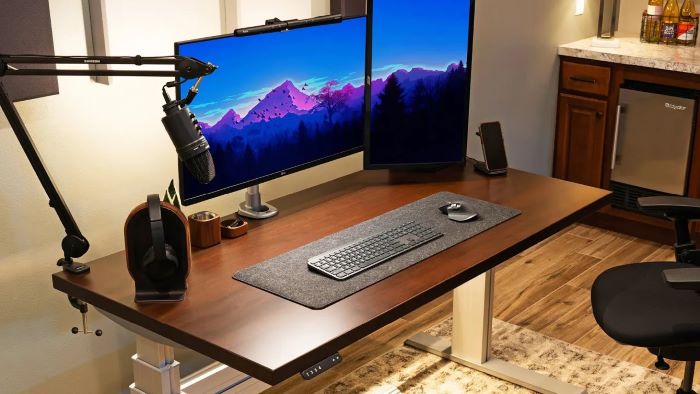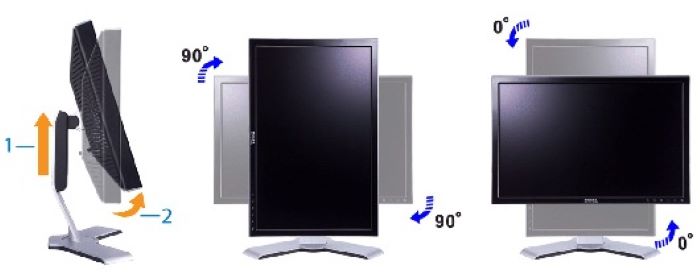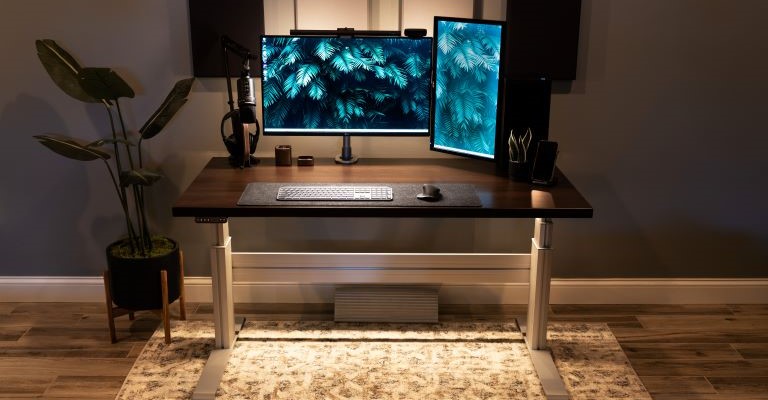Welcome to a new era in productivity and comfort—vertical monitor orientation. This game-changing experience offers a variety of benefits that can significantly improve your work lifestyle. In this article, we will explore the top 5 reasons to see if making the switch to a vertical monitor makes sense for you. Prepare to discover how this shift can contribute to a more ergonomic and organized space.
Full Disclaimer: We are an office furniture dealer and sell some of the products we review. To learn more about the products we sell, our review process and why you can trust us, please visit: Why we’re different. Who is BTOD.com and The Breakroom Blog?
Vertical Monitor Orientation Links
- Reduced Neck Strain
- Increased Document Visibility
- Improved Multitasking Capabilities
- Space-Saving Design
- Comfortable Reading Experience
- Vertical Made Easy
1. Reduced Neck Strain
To start off, a vertical monitor serves as a strategic ergonomic solution to reduce neck strain by aligning with the natural movement of the eyes and promoting smooth viewing angles. This orientation minimizes the need for constant head and wrist movement which can become uncomfortable during extended periods of use.

By maintaining a neutral and comfortable posture, users can stay focused on their tasks without experiencing unnecessary strain on their necks. This shift in workspace orientation prioritizes both performance and the long-term health of individuals.
2. Increased Document Visibility
One of the key advantages of using a vertical monitor is the longer vertical field of view it provides. This allows for more content to be visible without the need for scrolling or switching between tabs. It is particularly beneficial for reading and editing documents, as it contributes to a more efficient and uninterrupted work experience.

Users can easily navigate through extensive data without losing context or having to search for specific information. The longer vertical field of view enhances productivity and saves time.
3. Improved Multitasking Capabilities
Moreover, there are improved multitasking capabilities with a vertical monitor. Users can effortlessly split their screens and have multiple documents or applications open side by side. Deadlines become less of a struggle.

This feature enables an easy and organized workflow, making it especially beneficial for professionals such as researchers, writers, or project managers who require a high level of engagement. With a vertical monitor, users can easily switch between tasks and have all the necessary information readily available, enhancing productivity.
4. Space-Saving Design
In addition, having a vertical monitor offers a compact yet powerful solution for improving desk space. Their upright orientation makes them particularly important for those working in tight or shared environments. Their space-saving design also implements a more organized and visually appealing workspace, reducing the need for chaotic setups.

This provides a clear view of content which minimizes the need for additional screens, promoting a minimalist and efficient desk layout. Vertical monitors don’t just make your workspace look nice, but also help users make the most of their available space while maintaining functionality. Choosing a vertical monitor is a smart move for people that have limited room.
5. Comfortable Reading Experience
Lastly, vertical orientation mimics the layout of books and documents, providing a more natural and comfortable reading experience. It reduces the need for excessive eye movement and allows users to focus better on what they are reading. Having a vertical orientation actually increases font size as well so you can read faster and not have to think as hard.

Whether you’re working, reading interesting articles, or diving into a sea of information, a vertical monitor can turn your reading experience into something enjoyable. It’s easier on the eyes and helps improve productivity by reducing eye strain and fatigue.
6. Vertical Made Easy
I know a lot of you might be wondering if you can just rotate your screen vertically, and the good news is, yes, you can! The key to doing this is how your screen is set up. If you tweak your mount or stand and mess around with your computer settings a bit, you can easily switch to a vertical setup.

But there’s a catch—vertical screens can sometimes catch more glare from lights compared to horizontal ones. So, while it’s a cool switch, you might have to deal with a bit more glare. If you end up not liking the vertical setup, then simply switch it back. In our office, we have a few people that use vertical orientation and really like it especially when using more than one screen.
Bottom Line
Ultimately, deciding on a vertical monitor is a wise move for anyone wanting to improve their work setup. It brings lots of ergonomic perks and is an excellent way to find the right mix of getting things done comfortably and efficiently.
FAQ’s: Switching to a Vertical Setup
1. Can all monitors switch to vertical?
Yes, it is possible. You have to make sure the stand allows your monitor to rotate or use with monitor arm (check Vesa compatibility).
2. Do I have to buy a specific vertical monitor?
No, all monitors should be able to work vertically by switching your settings.
3. Why choose a vertical orientation?
It has many benefits as stated above and increases comfort
4. What are the cons of vertical monitors?
There may be more light glare and may take time to adjust
5. What is vertical orientation?
It is when your monitor is turned vertically instead of horizontal
6. Do people like vertical orientation?
It really depends on your preference. But yes, people generally say it feels more natural to read documents
Additional Office Resources





